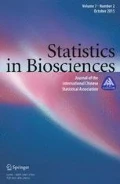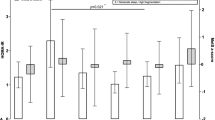Abstract
Sleep duration is a recognized determinant of mental health, obesity and cardiovascular disease, cognition, and memory across the lifespan. Due to convenience and cost, sleep duration is often measured through self-report; yet, self-reported sleep duration can be highly biased. Actigraphy is a viable alternative as an objective measure of sleep. To analyze this actigraphy data, various sleep evaluation algorithms have been developed using regression methods, with coefficients constructed on minute-by-minute data measured at a specific device placement (wrist or hip). Because activity counts per minute may be affected by various factors in the study (e.g., type of device, sampling frequencies), regression-based algorithms developed within specific populations may not be generalizable to wider use. To address these concerns, we propose a new learning method to obtain robust and consistent sleep duration estimates. First, we identify temporal segments via pruned dynamic programming; then, we develop a calling algorithm with individual-specific thresholds and capture sleep periods. Our proposed method is motivated by and demonstrated in the Multi-Ethnic Study of Atherosclerosis (MESA) Sleep study and the Early Life Exposure in Mexico to ENvironmental Toxicants (ELEMENT) study.





Similar content being viewed by others
References
Bai J, Di C, Xiao L, Evenson KR, Lacroix AZ, Crainiceanu M, Buchner DM (2016) An activity index for raw accelerometry data and its comparison with other activity metrics. PLoS ONE 11(8):1–14. https://doi.org/10.1371/journal.pone.0160644
Bild DE, Bluemke DA, Burke GL, Detrano R, Diez Roux AV, Folsom AR, Greenland P, Jacobs DR, Kronmal R, Liu K, Nelson JC, O’Leary D, Saad MF, Shea S, Szklo M, Tracy RP (2002) Multi-ethnic study of atherosclerosis: objectives and design. Am J Epidemiol 156(9):871–881. https://doi.org/10.1093/aje/kwf113
Brønd JC, Arvidsson D (2016) Sampling frequency affects the processing of ActiGraph raw acceleration data to activity counts to activity counts. J Appl Physiol 120(3):362–369. https://doi.org/10.1152/japplphysiol.00628.2015
Campanini MZ, Lopez-Garcia E, Rodríguez-Artalejo F, González AD, Andrade SM, Mesas AE (2017) Agreement between sleep diary and actigraphy in a highly educated Brazilian population. Sleep Med 35:27–34. https://doi.org/10.1016/j.sleep.2017.04.004
Cleynen A, Koskas M, Lebarbier E, Rigaill G, Robin S (2014) Segmentor3IsBack: an R package for the fast and exact segmentation of Seq-data. Algorith Mol Biol 9(1):6, arXiv:1204.5564v3
Cole RJ, Kripke DF, Gruen W, Mullaney DJ, Gillin JC (1992) Technical note: automatic sleep/wake identification from wrist activity. Sleep 15(5):461–469
Dean DAn, Goldberger AL, Mueller R, Kim M, Rueschman M, Mobley D, Sahoo SS, Jayapandian CP, Cui L, Morrical MG, Surovec S, Zhang GQ, Redline S, (2016) Scaling up scientific discovery in sleep medicine: the national sleep research resource. Sleep 39(5):1151–1164. https://doi.org/10.5665/sleep.5774
Domelen DRV, Pittard WS (2014) Flexible R Functions for Processing Accelerometer Data, with Emphasis on NHANES 2003–2006 Flexible R Functions for Processing Accelerometer Data, with Emphasis on NHANES 2003–2006. R J 6(2)
Gangwisch JE, Heymsfield SB, Boden-albala B, Buijs RM, Kreier F, Pickering TG, Rundle AG, Zammit GK, Gangwisch JE, Malaspina D (2006) Short sleep duration as a risk factor for hypertension analyses of the First National Health and Nutrition Examination Survey. Hypertension 47(5):833–839. https://doi.org/10.1161/01.HYP.0000217362.34748.e0
Gottlieb DJ, Punjabi NM, Newman AB, Resnick HE, Redline S, Baldwin CM, Nieto FJ (2017) Association of sleep time with diabetes mellitus and impaired glucose tolerance. Arch Intern Med 165(8):863–867
Hedner J, Pillar G, Pittman SD, Zou D, Grote L, White DP (2004) A novel adaptive wrist actigraphy algorithm for sleep-wake assessment in sleep apnea patients. Sleep 27(8):1560–1566
Knutson KL (2010) Sleep duration and cardiometabolic risk: a review of the epidemiologic evidence. Best Pract Res Clin Endocrinol Metab 24(5):731–743. https://doi.org/10.1016/j.beem.2010.07.001
Kölling S, Endler S, Ferrauti A, Meyer T, Kölling S, Endler S, Ferrauti A, Meyer T (2016) Comparing subjective with objective sleep parameters via multisensory actigraphy in German physical education students comparing subjective with objective sleep parameters via multisensory actigraphy in German physical education students. Behav Sleep Med 14(4):389–405. https://doi.org/10.1080/15402002.2015.1017096
Lauderdale DS, Knutson KL, Yan LL, Liu K, Rathouz PJ (2008) Sleep duration: how well do self-reports reflect objective measures? The CARDIA Sleep Study. Epidemiology 19(6):838–845. https://doi.org/10.1097/EDE.0b013e318187a7b0.Sleep
Maidstone R, Hocking T, Rigaill G, Fearnhead P (2017) On optimal multiple changepoint algorithms for large data. Stat Comput 27(2):519–533. https://doi.org/10.1007/s11222-016-9636-3. arXiv:1409.1842
Patel SR, Zhu X, Storfer-Isser A, Mehra R, Jenny NS, Tracy R, Redline S (2009) Sleep duration and biomarkers of inflammation. Sleep 32(2):200–204. https://doi.org/10.1093/sleep/32.2.200
Perng W, Tamayo-Ortiz M, Tang L, Sánchez BN, Cantoral A, Meeker JD, Dolinoy DC, Roberts EF, Martinez-Mier EA, Lamadrid-Figueroa H, Song PX, Ettinger AS, Wright R, Arora M, Schnaas L, Watkins DJ, Goodrich JM, Garcia RC, Solano-Gonzalez M, Bautista-Arredondo LF, Mercado-Garcia A, Hu H, Hernandez-Avila M, Tellez-Rojo MM, Peterson KE (2019) Early life exposure in Mexico to ENvironmental Toxicants (ELEMENT) Project. BMJ Open 9(8):1–14. https://doi.org/10.1136/bmjopen-2019-030427
Reynolds CF 3rd, Grochocinski VJ, Monk TH, Buysse DJ, Giles DE, Coble PA, Matzzie JV, Doman J, Monahan J, Kupfer DJ (1992) Concordance between habitual sleep times and laboratory recording schedules. Sleep 15(6):571–575
Rigaill G (2010) Pruned dynamic programming for optimal multiple change-point detection. arXiv:1004.0887
Sadeh A, Sharkey KM, Carskadon MA (1994) Activity-based sleep-wake identification: an empirical test of methodological issues. Sleep 17(3):201–207. https://doi.org/10.1093/sleep/17.3.201
St-Onge MP, Roberts AL, Chen J, Kelleman M, O’Keeffe M, RoyChoudhury A, Jones PJH (2011) Short sleep duration increases energy intakes but does not change energy expenditure in normal-weight individuals. Am J Clin Nutr 94(2):410–416. https://doi.org/10.3945/ajcn.111.013904
Taheri S, Lin L, Austin D, Young T, Mignot E (2004) Short sleep duration is associated with reduced leptin, elevated ghrelin, and increased body mass index. PLoS Med 1(3):e62. https://doi.org/10.1371/journal.pmed.0010062
Tudor-Locke C, Barreira TV, Schuna JM, Mire EF, Katzmarzyk PT (2014) Fully automated waist-worn accelerometer algorithm for detecting children’s sleep-period time separate from 24-h physical activity or sedentary behaviors. Appl Physiol Nutr Metab 39(1):53–57
Van Hees VT, Sabia S, Anderson KN, Denton SJ, Oliver J, Catt M, Abell JG, Kivimäki M, Trenell MI, Singh-Manoux A (2015) A novel, open access method to assess sleep duration using a wrist-worn accelerometer. PLoS ONE 10(11):1–13. https://doi.org/10.1371/journal.pone.0142533
Wolfson AR, Carskadon MA (1998) Sleep schedules and daytime functioning in adolescents. Child Dev 69(4):875–887. https://doi.org/10.1111/j.1467-8624.1998.tb06149.x
Wong WW, Ortiz CL, Lathan D, Moore LA, Konzelmann KL, Adolph AL, Smith EO, Butte NF (2013) Sleep duration of underserved minority children in a cross-sectional study. BMC Public Health 13(1):648. https://doi.org/10.1186/1471-2458-13-648
Zhang GQ, Cui L, Mueller R, Tao S, Kim M, Rueschman M, Mariani S, Mobley D, Redline S (2018) The National Sleep Research Resource: Towards a sleep data commons. J Am Med Inform Assoc 25(10):1351–1358. https://doi.org/10.1093/jamia/ocy064
Acknowledgements
This research is supported by National Institute of Environmental Health Sciences Grant R01ES024732. Dr. Jansen is funded through a T32 grant from the National Institute of Diabetes and Digestive and Kidney Diseases (Grant No. 5T32DK071212-12). MESA is supported by NHLBI funded contracts HHSN268201500003I, N01-HC-95159, N01-HC-95160, N01-HC-95161, N01-HC-95162, N01-HC-95163, N01-HC-95164, N01-HC-95165, N01-HC-95166, N01-HC-95167, N01-HC-95168 and N01-HC-95169 from the National Heart, Lung, and Blood Institute, and by cooperative agreements UL1-TR-000040, UL1-TR-001079, and UL1-TR-001420 funded by NCATS. MESA Sleep was supported by NHLBI R01 L098433.
Author information
Authors and Affiliations
Corresponding author
Ethics declarations
Conflict of interest
The authors declare that they have no conflict of interest.
Additional information
Publisher's Note
Springer Nature remains neutral with regard to jurisdictional claims in published maps and institutional affiliations.
Supplementary Information
Below is the link to the electronic supplementary material.
Rights and permissions
About this article
Cite this article
Baek, J., Banker, M., Jansen, E.C. et al. An Efficient Segmentation Algorithm to Estimate Sleep Duration from Actigraphy Data . Stat Biosci 13, 563–583 (2021). https://doi.org/10.1007/s12561-021-09309-3
Received:
Revised:
Accepted:
Published:
Issue Date:
DOI: https://doi.org/10.1007/s12561-021-09309-3




